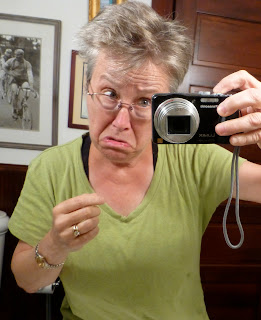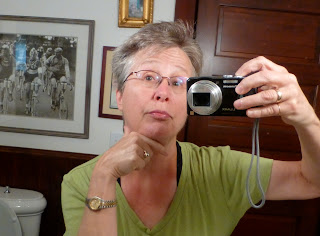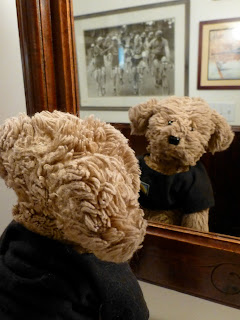I brought up the Left-Gaze Bias in the last post. Evidently, we humans look at each other most avidly on the left side as we’re facing each other (the gazee’s right side). That’s where we have learned to read each other’s emotions, because that’s where they leak out, propelled by our emotional left brains. But this bias also has implications when it comes to looking in the mirror. When we look at ourselves in the mirror, we look at the left side the most. It’s just force of habit. Ideally, you should be well enough attuned to your own emotions that you don’t need to check out your right eyeball to find out what they are. But the problem is that the mirror has the sides flipped, so we’re no longer looking at the tell-tale side, the side that everyone else looks at. That means we tend not to like photographs of ourselves, because they’re all backwards and the eye we’re used to looking at is on the wrong side. When I see a photo of myself, I instantly notice the gigantic mole on my right eyebrow, which looks unusually prominent because I’m usually looking at the other side in the mirror. This means when other people look at my face, they’re looking at my mole. And they can read my emotions. My primary emotion is “shit. You’re looking at my mole.”
This is not a problem with all animals. Flatfish start out looking like regular fish with an eye on either side of their skinny vertical bodies and then one of their eyes begins to migrate over the top of their head and joins up with the other one, and they flop over ninety degrees and drift to the bottom of the sea and gaze up with both eyes now on the top side. When all is said and done, it doesn’t look right. It’s never even. If young flatfish ever do try to look at each other’s right side, next time they meet they might find the entire side has shlorped over to the left side. This would be fatally disconcerting, in a social sense, and so it is assumed that flatfish are not well developed emotionally.
In some social situations, this mirror business causes problems. Many times when people take photos of themselves to use in, say, social networking sites, they snap a photo in the mirror. This is one of the
reasons people complain that the person they met on line does not look at all like his picture. When Heather goes to meet that cute boy Jason she met on line and is disappointed in him in person, it might be because Jason had taken a picture of himself in the mirror. Also he’s forty-seven years old with soiled pants.
Mirrors have been used by scientists to gauge self-awareness among many species, including humans. In the typical mirror test, a bit of schmutz is dabbed on the animal in a spot it could see only by looking in the mirror. If he reaches out to the schmutz on himself, he is said to pass the mirror test. That is, he recognizes that the image in the mirror is him. The human child undergoes a predictable pattern of responses to a mirror. At up to a year, the child sees the reflection as another possible playmate. Self-admiring begins at one year, followed by avoidance behaviors, which go away and do not resurface until menopause.
Not too many other animals pass the mirror test, but among them are all the great apes. Lesser primates have been shown to be significantly less narcissistic. Pigs can use a mirror to find food, but because they really do not give a rat’s ass how they look or how much schmutz they have on them, human scientists have assumed a lack of self-recognition. Cows are not expected to develop self-recognition until they evolve fingers. Results with rutting elk and mirrors are inconclusive, but seem likely to result in seven years of bad luck.
This field of mirror research is still new, and the science about Donald Trump is unsettled. He is said to do his own hair, which leads some researchers to conclude he has a mirror, and others to conclude he couldn’t possibly.




Hey, wait a minute. Now you've got me confused. You mean, when I look in a mirror my left side is actually my right side? Somehow that doesn't seem right, side that is. I think I'll go look in the mirror. No, bad idea at this time of the morning.
BTW, dolphins are totally mirror self-aware, even posing for themselves.
If I looked like a dolphin, I wouldn't stop looking in the mirror and smiling.
If lesser primates like baboons don't pass the mirror test for self-awareness, I don't see how Trump could.
In British dialect "trump" means "fart". Seems fitting somehow.
Really? I did not know that. Bet it's short for trumpet. It would be in this house.
In attempting to test your observations, I stood before a mirror. I am now so confused that I have no idea what I feel. Or think.
The mirror throws me every time, too. Gaaah!
Rutting elks + mirrors = mirrors lose every time. I bet there will be scientists vying for a billion trillion dollars worth of funding to study this any minute. Less of a waste of money than studying The Donald. I'm on the "he couldn't possibly have a mirror" side.
I do believe he puts the lie to the argument that it's a good thing to have a lot of self-esteem.
I've long been of an age that mirrors must be approached with a degree of caution and prior preparation. There's nothing worse for me than being waylaid by a surprise mirror when I'm browsing in a department store.
One time shortly after I turned forty I got waylaid by one of them and caught my neck swaying in the breeze. It was terrifying.
From an early age I made a habit of just looking at minuscule portions of myself in mirrors. An eye, an ear, an elbow.
I am not interested in the so-called complete picture.
What would research say about me?
XO
WWW
You're a detail person?
I don't need a mirror to know that I probably have schmutz on my face. Now THAT is self awareness!
I like you, Leslie.
Well, what do you know? And I thought I just gave someone the once-over and decided they were sad. Now I'm told there's all sorts of mysterious interchanges and reversals going on, unbeknownst, in my devious little brain. Goodness knows what other tricks this mischievous organ is playing on me.
To quote a great American, Goodness has nothing to do with it.
Is this why we drive on the right side of the road, to see the oncoming crazy better?
I am not reliably on the right side of the road, myself, because I'm trying to see raptors in the sky. Just letting you know.
If I were you, Murr, I'd look in the mirror all day just to admire that great haircut!
Barb's sucking up! Thanks! I think this will be it for the rest of my life. I got a barber around the corner who does it for eleven bucks.
I know what you mean about the difference between how we see ourselves in the mirror and what we see in photos. I'm always amazed by how I notice my flaws in pictures, whereas I look passable enough in my mirror!
I used to be horrified by photos of myself, but after almost five years of putting in ridiculous photos in this blog, I'm kind of over it.
I try not to look in mirrors. I feel better than I think I look.
Heard that.
I only laughed at the part of this post that starts,
"I brought up the Left-Gaze Bias in the last post." and ends,
"He is said to do his own hair, which leads some researchers to conclude he has a mirror, and others to conclude he couldn't possibly."
The rest…not so much!
Oh joeh, I hope to continue boring you in this manner!
I dislike going to hair-dressers because a) I have to sit surrounded by god-awful images of myself and b)I have to listen to stupid chatter.
I go to a single-chair barber and she doesn't exactly speak English. And I have to take my glasses off. The whole experience is like sensory-deprivation except for the playing-with-hair part. So, just about perfect.
Murr, I don't know where to start so I'll just say, Happy August.
Ain't you sweet. We're having a good one here. Not so dang hot, but warm enough to enhance the beer experience.
I do not like mirrors, especially the one in my master bathroom that is 6 feet wide and 4 feet tall. I must pass it whenever I exit the shower to go and dress in the other room. I would love to get rid of it and put 2 small mirrors in front of each sink. The present one is so heavy!! Would you want to have it??????
No. I'm still visualizing the two small mirrors above the sink. I'm thinking one would have to be a little lower than the other.
You may catch him in front of the short error saying, "Lookin' good there, Sport!"
I remember looking at pictures of famous people and noticing how one eye was different from the other; In particular, with powerful people, how their right eye seemed regular, while the left was more removed, cold and evaluating. This seems to go with your info about looking at the right side of the face (the side to our left) for emotional cues. I feel compelled now to check myself out in the mirror but I'm afraid.
Yeah, don't worry about it. You won't look at the side with the goods, anyway. Your secrets are safe from you.
I remember looking at pictures of famous people and noticing how one eye was different from the other; In particular, with powerful people, how their right eye seemed regular, while the left was more removed, cold and evaluating. This seems to go with your info about looking at the right side of the face (the side to our left) for emotional cues. I feel compelled now to check myself out in the mirror but I'm afraid.
This makes me happy to be bald, but I am clueless about detecting my feelings by looking in the mirror. As an emotional cripple, it's probably a good thing.
Now, it's not nice to discriminate against yourself.
Just love your reflections . . .
Oh, I see what you did there!
Lately when I look into my mirror all I see is the rash of pimples from god-knows-what. I never had pimples as a teen, so have no idea how to treat or get rid of them now. Or why I have them now. I'll have to do a foods elimination test.
Usually I just use the mirror to check I don't have food in my teeth or toothpaste on my chin.
You look nice in your mirror.
You might leave the toothpaste on your chin to help dry up the pimples. Dave never had pimples as a teen and now, every seven years when he gets one, he gets a little panicky. I had them. Boy howdy, I had them.
It gets worse, if you think about it. When you look in a mirror, right and left and reversed, but top and bottom aren't. Blows my tiny mind. The point about mirror selfies is a good one, and I will use that in all future defences as to why women find me unattractive. Thanks a bunch. Indigo x
You could maybe draw little arrows so they know which side of the face they should be looking at, and I'll bet that solves what little problem you have there.
If the left brain in controlling your emotions, it should show on the right side of the face. Of course, I could be wrong. Hell, my brain hurts…Too much information to process…If you want to watch yourself having sex in the mirror which side do you place the mirror – your left or her left? That's more of a man dilemma – I am just guessing; but that is probably the only time a woman would like to avoid a mirror – but what do I know?
the Ol'Buzzard
Oh hell no. Some of us always avoid a mirror. I didn't even have one until about fifteen years ago. People used to look at me and even say, "hey, you don't have a mirror at home, do you?"
I learned recently that self-portraits taken for use on social media are called "selfies." I've tried, and I can't get one in which I'm happy with either side of my face. I got stuck one day listening to a conversation about whether someone had a "bathroom picture" on her phone. "Everybody has one," they said. It took me three days to realize they were talking about selfies.
Don't feel bad. I think that, truth be told, some of this information we're not keeping up with is not actually that important.
On the other hand, when I got my first digital camera, I didn't know it had video on it, and I accidentally hit the button for it once, and thought (since it didn't seem to be taking a picture) that it was out of juice, so I walked inside with it and went to the bathroom–all of which was captured on the video (floor shots).
This just made me laugh out loud. I still get video by accident sometimes, but never with such dramatic results.
"That means we tend not to like photographs of ourselves, because they're all backwards and the eye we're used to looking at is on the wrong side"
I think that's why I like the front facing camera option on my iPhone so much – because the photo comes out the way I look to myself in the mirror.
"When Heather goes to meet that cute boy Jason she met on line and is disappointed in him in person, it might be because Jason had taken a picture of himself in the mirror. Also he's forty-seven years old with soiled pants"
That cracked me up!
Oh, we've all been there, right?
I use the photo-booth thingy on my iMac to tweeze chin hairs. And then I go to click it off and accidentally hit the camera button and it flashes. Scares me to pieces. I might not be pioneer stock.
I don't know … a lot of adult women look in the mirror and see a playmate too! That's the only way to explain certain styles of hair and dress, isn't it??
I'm thinking that the phenomenon of older women tarting up and thinking they've still got it going on is related to the phenomenon of men and combovers.
Older women sometimes dress inappropriately for their age and body type because we know that no one actually looks at us anyway. Yoga pants are comfortable and washable. And if you notice that they seem to give me a camel toe, look elsewhere.
Or, as a younger friend of mine once observed as I strolled out into the front yard, "you really don't care, do you?"
Now I'm too confused to comment….
And yet, you managed it!
Either my teeth are getting more crooked, or I'm noticing it more. Tried one of those sophisticated black and white photo shoots on the cruise. Thank God you didn't have to pay if you didn't like it. When I smile in the mirror, it doesn't look like I could eat tomatoes through a tennis racket, but those pictures made me look like Hagatha. If that's how I really look, I'm surprised children don't run screaming. More often.
I've got the same kind of thing going on. Blog post to follow. Really, my teeth are starting to push my lips out, and I drool enough already.
Yes! Mine are pushing forward on one side only – the side I sleep on 90 percent of the time … how do I push 'em back??
Could you roll over? Really, jenny o, I think you may be sleeping too hard.
Sadly, no – bad hip.
And, yes, I take sleeping very seriously. It's usually the best seven hours of my day 🙂
A blog post worthy of much reflection..
I don’t know the question, but sex is definitely the answer. Hey, i am looking for an online sexual partner 😉 Click on my boobs if you are interested (. )( .)